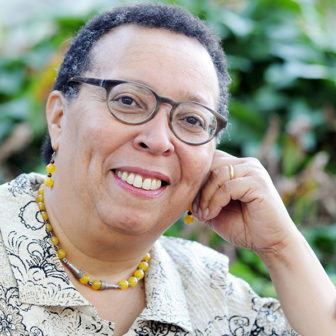
weedezign/Shutterstock
.
High-quality preschool is the gift that keeps on giving. At least that’s what Nobel Prize-winning economist Jim Heckman’s research shows. The IQ scores of the 123 low-income children who attended Perry Preschool in Ypsilanti, Mich., did not improve significantly as was hoped.
Nonetheless, the preschool experience altered their life trajectories. At age 40, the effects were still evident. Participants were more likely to have graduated high school, hold a job and own their own home. They also had committed fewer crimes and had fewer teenage pregnancies.
Now, 50 years later, Heckman’s research shows that the effects of the Perry Preschool Project transferred to the participants’ children. His explanation is simple but powerful. Even when living in the same neighborhoods and enrolled in the same schools, Perry parents were better able to create stable family environments for their children.

Karen Pittman
Why? Perry Preschool participants went off to elementary school confident of their ability to navigate new environments. Their experiences provided them with a backpack full of competencies that helped them succeed academically and socially. Equally important, these competencies helped them navigate challenges and persevere when discouraged. In today’s language, these children were immersed in a learning environment that built their social, emotional and cognitive skills.
Heckman is quick to point out that the intervention is not any preschool, it is high-quality preschool. Specifically, a preschool environment that uses a balanced, participatory approach to learning and systematically encourages parents to do the same. David Weikart, the founder of the HighScope Educational Research Foundation that created the preschool and conducted the original longitudinal study, called this “active learning — learning in which the child, by acting on objects and interacting with people, ideas, and events, constructs new understanding.”
What Heckman doesn’t point out is that this active learning approach is also applicable for older children, teens and even young adults.
Weikart’s vision was not just to transform preschool, it was to transform K-12 education: “The High/Scope Institute is committed to the philosophy that a multifaceted, rich environment that offers participants the chance to explore, participate in a community and actively experience new things will foster not only greater academic success but also greater social adjustment.”
In 1963, Dave and his wife Phyllis established a residential summer camp for teenagers to test the applicability of this approach with teens. The camp was the learning ground for the development, testing and codification of a bold new program model. They demonstrated that they could train undergraduate students to use this “active learning” approach to transform a group of 50 to 60 teens from diverse backgrounds into a vibrant community of confident learners.
In 1981, High/Scope tailored this model to respond to the concerns of an intermediate school district in rural Michigan that wanted to better tap the potential of their low-income students. The rebranded High/Scope Institute for IDEAS offered underachieving sophomores or juniors from Lower Michigan a one-month residential camp experience in May. In 1987, the program expanded to include students from the Detroit Public Schools. This step significantly increased diversity and allowed the program to include components aimed at fostering positive understanding and interaction between campers from different racial groups and geographies but with very similar family backgrounds.
Can we scale quality?
To test the impact of the Institute for IDEAS, Weikart mounted a follow-up evaluation of the 1982 and 1983 campers and a comparison group of students. Documented in “Challenging the Potential,” this longitudinal study found the same pattern. Five years after the intervention, the program subjects were found to be more likely to have gone on to postsecondary education, a finding more pronounced for those who were not “recognized achievers” in high school and those whose parents did not have high expectations for their child’s education. Again, the determining factor is these students’ increased social competencies and social capital. Campers reported broader influences than did the comparison group, including friends, nonfamily role models, and experiences (like the Institute for IDEAS.)
Why is it important to know that high-quality learning experiences could potentially change life trajectories even when introduced in adolescence? The powerful research on the importance of social and emotional skills (or life skills) that has made Jim Heckman a champion of high-quality early childhood education has two new twists. Powerful new brain science shows that these skills develop throughout adolescence. The new research on how learning happens emphasizes the importance of creating high-quality learning environments like those described in the High/Scope active learning model.
Why is it important to know more about David Weikart’s work? Heckman’s bullish stance on early childhood programs does not translate to adolescent programs because of a lack of evidence. There are only a few longitudinal studies of programs and these have mixed results. The HighScope Institute for Ideas, however, was not a program. It was the testing ground for a scalable approach to training adults who work with youth.
In the conclusion to “Challenging the Potential,” Weikart and his colleagues did call for expanding the number of programs available to students (Challenging the Potential reviews 13 such programs). But the authors’ strongest recommendations focused on improving adult practice. Weikart made strong recommendations that included enhanced teacher training to better interact with students, restructured instructional practice to be more active and participatory, and increased opportunities for staff and other adults to serve as role models. These supports would provide structure that would reflect a “change [of] our view of talented disadvantaged and minority students’ potential for achievement,” matching a “firm belief that our higher expectations will enhance their achievement.”
Quality education is a powerful antidote to poverty and inequality. More without better, however, can lead to victim blaming. Cutting corners, emphasizing quantity over quality, implementing piecemeal programs in lieu of broad-scale policy and practice reforms increases the likelihood that the return in investment is declared insufficient. Low returns on investment reinforce the already dangerous perception that poor families and families of color either need too much or care too little to be worth systematic investments.
The big policy question, then, is can we scale quality in schools, youth organizations, prevention and child welfare programs? The answer is yes, if we focus on scaling practices and approaches, not complex programs. For example, the Forum’s Weikart Center for Youth Program Quality — a mighty team of 25 staff and a set of consultants — currently support continuous quality improvement efforts of more than 140 state and local OST networks and systems that train and support 25,000-plus staff and reach more than 340,000 youth.
The intervention — and it is a validated intervention — is not a curriculum. It is a sequenced process for helping system and program leaders create management, coaching and training, and data processes needed to help adult practitioners working in a wide array of programs improve their craft.
Karen Pittman has made a career of starting organizations and initiatives that promote youth development — including the Forum for Youth Investment, which she co-founded with Merita Irby in 1998. Karen was recently selected to join the National Commission on Social, Emotional, and Academic Development with the Aspen Institute.































